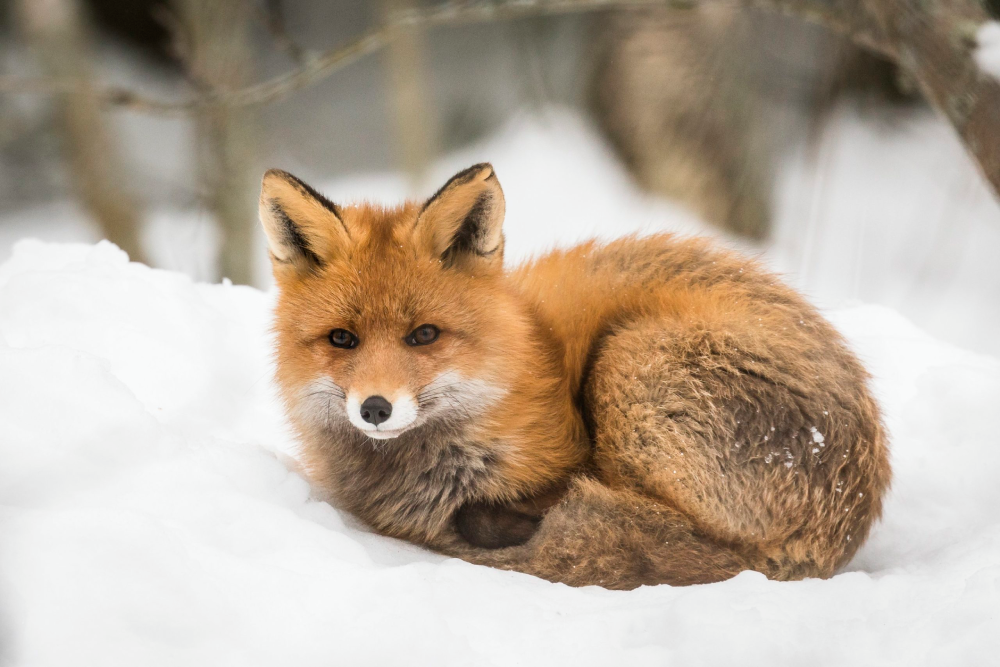The red fox (Vulpes vulpes) is one of the most widespread and adaptable mammals in the world. Known for its striking reddish coat, bushy tail, and cunning behavior, the red fox has captured the human imagination for centuries, appearing in folklore, literature, and popular culture. This article delves into the biology, behavior, habitat, and cultural significance of the red fox, providing a comprehensive overview of this fascinating species.
Physical Characteristics
Red foxes are in medium-size canids with a distinctive appearance. They typically have a reddish-brown coat, although the color can range from light yellowish-red to deep auburn. Their undersides are usually white or gray, and they have black markings on their legs, ears, and tail. One of the most recognizable features of the red fox is its bushy tail, often tipped with white, which provides balance and warmth.
Adult red foxes weigh between 3 to 14 kilograms (6.6 to 31 pounds) and measure 45 to 90 centimeters (18 to 35 inches) in body length, with tails adding an additional 30 to 55 centimeters (12 to 22 inches). Males are generally larger than females, but there is considerable overlap in size.

Adaptations
Red foxes have several adaptations that contribute to their survival. Their keen senses of hearing, smell, and sight make them effective hunters. Their ears can rotate to detect the direction of sounds, which is crucial for locating prey. The fox’s fur provides insulation against cold weather, and the varied coloration helps with camouflage in different environments.
Habitat and Distribution
The red fox live across North America, Europe, Asia, and North Africa. They have also been introduced to Australia, where they are considered an invasive species due to their impact on native wildlife.
Red foxes are highly adaptable and can thrive in a wide range of habitats, including forests, grasslands, mountains, deserts, and urban areas. They often live in close proximity to human settlements, where they scavenge for food. Their adaptability to diverse environments is one of the reasons for their extensive range.
Diet and Hunting Behavior
Red foxes are omnivores with a diverse diet that includes small mammals, birds, insects, fruits, and vegetables. Their diet can vary significantly depending on the season and availability of food. In rural areas, they primarily hunt rodents and rabbits, while in urban settings, they may scavenge from garbage bins or consume pet food left outside.
Foxes employ various hunting techniques, such as stalking, pouncing, and digging. They are popular for their characteristic hunting leap, where they spring into the air to catch unsuspecting prey, often small rodents hidden under snow or grass. This behavior is not only efficient but also a spectacle of their agility and precision.
Reproduction and Life Cycle
The breeding season for red foxes typically occurs in the winter, with peak activity in January and February. During this time, males (dog foxes) compete for the attention of females (vixens). After a successful mating, the gestation period lasts about 49 to 55 days.
Vixens give birth to a litter of 2 to 12 kits, usually in an underground den. The kits are born blind and deaf, relying entirely on their mother for warmth and nourishment. The father and sometimes older siblings may assist in feeding and protecting the kits. The young foxes begin to explore outside the den at about four weeks old and are weaned by 8 to 10 weeks. By the time they are six months old, they start to hunt independently, and by autumn, they leave their family to establish their own territories.
Behavior and Social Structure
Red foxes are territorial animals, with territories ranging from 5 to 50 square kilometers (2 to 20 square miles), depending on food availability and population density. Territories are marked with scent glands and urine, and foxes communicate through vocalizations and body language to defend their range from intruders.
While red foxes are generally solitary, they exhibit a flexible social structure. In areas with abundant food, they may form small family groups consisting of a breeding pair and their offspring. However, adult foxes typically hunt and sleep alone, meeting only to mate or care for their young.
Interaction with Humans
Red foxes have increasingly adapted to urban environments, where they find ample food sources and shelter. Urban foxes often face fewer predators and have access to discarded food, leading to higher survival rates. Their presence in cities has led to a mix of fascination and conflict with humans, as they can sometimes be seen as pests.
Cultural Significance
The red fox has a rich cultural significance in many societies. In European folklore, they are often depicted as cunning and sly creatures, while in Japanese culture, the fox (kitsune) is seen as a mystical and intelligent being capable of shape-shifting. Native American cultures also have various myths and stories about the fox, portraying it as both a trickster and a wise figure.
Conservation Status
The red fox is classified as “Least Concern” by the International Union for Conservation of Nature (IUCN) due to its wide distribution and large population. However, specific populations may face threats from habitat destruction, hunting, and disease.
In some regions, red foxes are protected by law, and also efforts are made to manage their populations sustainably. Conservation measures include habitat preservation, research on fox ecology, and public education to reduce human-wildlife conflicts.
Conclusion
The red fox is a remarkable example of adaptability and survival. Its ability to thrive in diverse environments, coupled with its intriguing behavior and significant cultural impact, makes it a subject of enduring interest. As human landscapes continue to change, the red fox’s adaptability will likely ensure its continued presence and relevance in both natural and urban settings. In conclusion, by understanding and appreciating these animals, we can foster coexistence and ensure that future generations can also experience the wonder of the red fox.









